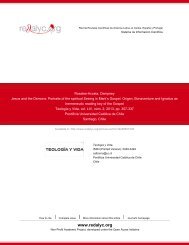A Key Concept in Modern Translation Theory - Redalyc
A Key Concept in Modern Translation Theory - Redalyc
A Key Concept in Modern Translation Theory - Redalyc
You also want an ePaper? Increase the reach of your titles
YUMPU automatically turns print PDFs into web optimized ePapers that Google loves.
SERGIO BOLAÑOS CUELLAR<br />
85<br />
is not justified to the extent that modern (text)l<strong>in</strong>guistics does take <strong>in</strong>to account<br />
the text as the unit of analysis with<strong>in</strong> the framework of a communicative event.<br />
If, as we state, translation is also a communicative event, then it is reasonable to<br />
expect modern l<strong>in</strong>guistics to strive to shed light on the complexity of translation<br />
as a process and as a product. In l<strong>in</strong>e with this argument we have proposed to<br />
analyze the key concept of equivalence from this perspective. In order to<br />
accomplish this goal we have devised a Dynamic <strong>Translation</strong> Model (DTM)<br />
which has proved useful both theoretically and practically. In our approach the<br />
po<strong>in</strong>t of departure and arrival <strong>in</strong> the translation process of establish<strong>in</strong>g equivalences<br />
between an SL-text and a TL-text is always the source language text. This<br />
dynamic process of the establishment of equivalences is seen as a problemsolv<strong>in</strong>g<br />
activity. Whenever one translates one tries to produce a TL-text equivalent<br />
to the SL-text as a whole, but due to the text complexity, i.e. to the fact that the<br />
text is a network of <strong>in</strong>terwoven relations, we have proposed to analyze (describe,<br />
expla<strong>in</strong>) the text <strong>in</strong>to different text-levels: (stylistic) syntactic, (stylistic) lexical,<br />
semantic, pragmatic, and semiotic. In the translation process the translator has<br />
necessarily to take <strong>in</strong>to account what we have called the conditions and<br />
determ<strong>in</strong>ants of the translation communicative event, i.e. participants’ sociopsychological<br />
characterization and competences, and the context (communicative<br />
event’s time and place and social, economic, historical and cultural factors<br />
surround<strong>in</strong>g it). Therefore, contrary to the common belief held by COT, with<strong>in</strong><br />
our l<strong>in</strong>guistics/text-oriented approach, the translator does resort to <strong>in</strong>ternal and<br />
external, non-l<strong>in</strong>guistic/contextual factors, <strong>in</strong> order to carry out his work.<br />
Our l<strong>in</strong>guistics/text-oriented approach, DTM, has also proved useful for<br />
criticiz<strong>in</strong>g translation products. This is a very demand<strong>in</strong>g task which requires that<br />
the critic basically duplicate the translator’s decision-mak<strong>in</strong>g, problem-solv<strong>in</strong>g activity<br />
when the latter was establish<strong>in</strong>g orig<strong>in</strong>ally the equivalence between SL-text and<br />
TL-text levels. This task requires that both texts be fully compared <strong>in</strong> order to be<br />
able to state an objectively balanced judgment as to the quality of the translation as<br />
a whole <strong>in</strong> terms of its ma<strong>in</strong> (frequently repeated and semantically and pragmatically<br />
outstand<strong>in</strong>g and relevant cases) strengths and weaknesses. <strong>Translation</strong> quality should<br />
tend to be homogeneous, i.e. with smooth peaks and troughs <strong>in</strong> the development of<br />
the translation wave, thereby keep<strong>in</strong>g the TL-text with<strong>in</strong> the equivalence range.<br />
BIBLIOGRAPHY<br />
ALBRECHT, J. (1973). L<strong>in</strong>guistik und Übersetzung. Tüb<strong>in</strong>gen, Niemeyer.<br />
ARROJO, R. (1994). “Deconstruction and the Teach<strong>in</strong>g of <strong>Translation</strong>”. TEXTconTEXT, pp. 1-12.
















